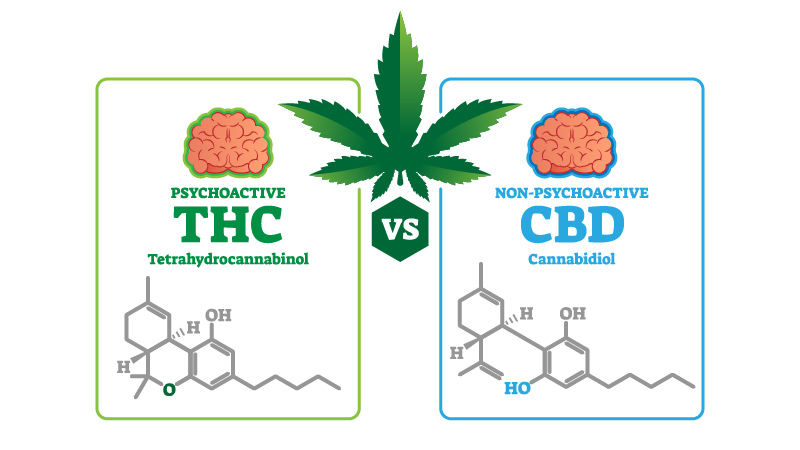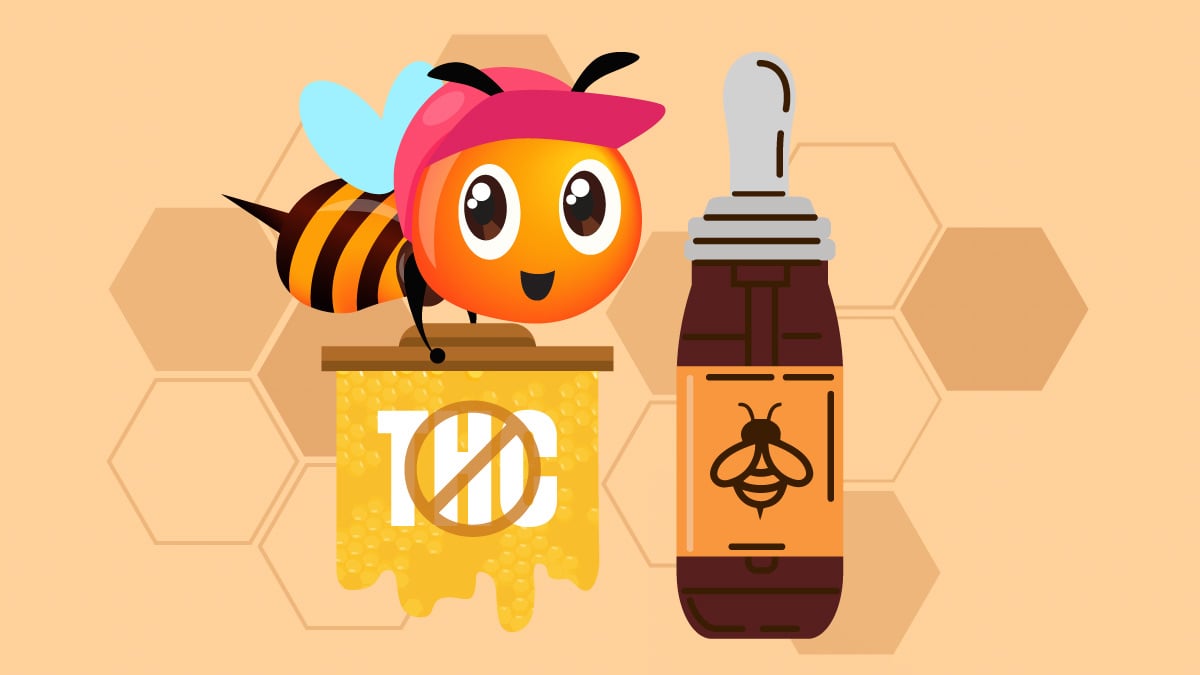Are you wondering why people are searching for CBD oil without THC?
There’s a good reason for it, although many users consider this kind of CBD extract an incomplete product.
We have read many stories of people getting false-positive results for THC after taking high doses of full-spectrum CBD oil regularly. Hemp-derived CBD oil contains only a negligible amount of THC (no more than 0.3%), which can’t produce a high associated with this molecule.
However, THC may get stored in the body over time, and this accumulation may result in a sufficient number of metabolites in your system to show a traceable amount on a drug screening.
CBD oil without THC is a nod toward CBD users who need to undergo a drug test for THC at their workplace. Many brands have expanded their product line up with an extract known as CBD isolate.
CBD isolate is exactly what it sounds like. It’s pure, isolated cannabidiol that has been separated from THC, other cannabinoids, and terpenes. CBD oil without THC has no odor and flavor, which makes it a more versatile product than its full-spectrum counterpart.
This article provides an explanation of the differences between CBD and THC, highlighting the pros and cons of THC-free CBD oils.
Differences Between CBD and THC
When you first look at the molecular profiles of CBD and THC, they seem to be pretty much the same. Both compounds contain 21 carbon atoms, 30 hydrogen atoms, and 2 oxygen atoms.
However, the way these atoms are arranged causes these cannabinoids to have different effects on your body and brain.
CBD and THC act similarly to the endocannabinoids produced by your body.
These endogenous neurotransmitters interact with the cannabinoid receptors in the endocannabinoid system (ECS). The ECS is a complex neurochemical network that regulates the functioning of all organ systems in the body — maintaining an internal balance between important biological functions.
The functions controlled by the ECS include memory, mood, cognition, appetite, immune function, reproductive health, neuroprotection, sleep cycles, sensory perception, and more.
CBD and THC have a different fashion of interacting with the ECS. Let’s take a closer look at them.
CBD and THC Use Different Pathways to Act on the Endocannabinoid System

The main difference in the interaction between these molecules and the ECS is the way they engage with cannabinoid receptors.
THC is the agonist of the CB1 receptor, which occurs mostly in the brain and central nervous system. The agonism means that THC directly binds to this receptor, which allows it to produce its signature effects, such as the feelings of bliss and euphoria.
That’s because THC is almost identical as anandamide in its chemical structure. Anandamide is one of the two major endogenous cannabinoids; it can also lead to feelings of relaxation, happiness, and euphoria upon release.
When you take THC, it causes your brain to think that more anandamide circulates in the bloodstream. High concentrations of anandamide in the body can trigger a euphoric high. On the other hand, high doses of THC that exceed a person’s tolerance to this compound may lead to opposite effects — causing temporary distress.
Taking CBD will cause you to experience something different due to its unique relationship with the ECS. Instead of attaching to cannabinoid receptors, it acts on them through the signaling of the ECS. When CBD enters the bloodstream, the ECS receives messages that stimulate it to produce more of its natural cannabinoids, including anandamide. CBD also blocks an enzyme that breaks down anandamide, so it can circulate in the body for longer.
When you take CBD, you won’t experience any type of high because the CBD modulates the activity of cannabinoid receptors instead of binding to them. CBD has adaptogenic properties; it works where your system needs it the most, ensuring healthy levels of endocannabinoids in your body without the side effects associated with taking too much THC.
How Much THC is in Full-Spectrum CBD Oil?
If a product is labeled as “full-spectrum CBD,” it means that it has been made with the entire hemp plant. Hemp contains negligible amounts of THC, typically 0.3% or less by dry mass. Hemp-derived products are legal throughout the United States as long as they meet the provisions set out in the 2018 Farm Bill.
Before the new Farm Bill was signed into law, hemp had been held in the same class of drugs like heroin, cocaine, and LSD. Today, hemp is an agricultural crop that can be harvested and sold for any purpose, including healthy supplements, such as CBD oil.
CBD Oil without THC: How do Manufacturers Remove THC from CBD?
CBD oils without THC are made by either purifying the CBD oil from the intoxicating cannabinoid — this is how isolates are made — or by removing THC from a full-spectrum extract to create the broad-spectrum version.
After the initial extraction, all cannabinoids and terpenes are separated from the plant matter using supercritical CO2, which is the golden standard industry, and our go-to extraction technology. Pressurized CO2 ensures pure hemp extracts that will remain consistently potent throughout all batches — without applying additional heat or toxic solvents such as butane.
Then, the mixture containing CBD, minor cannabinoids, terpenes, and trace amounts of THC, goes through a process called winterization. During this step, the extract is purified from any redundant plant matter, resulting in a filtered oil. After winterization, the manufacturer uses short-path distillation, a method that separates cannabinoids from the remaining compounds.
From there, the CBD extract can be processed in two ways.
The first way involves removing the THC from the whole, which results in a broad-spectrum extract. Broad-spectrum CBD evokes some of the entourage effect because it contains all the non-psychoactive cannabinoids and terpenes, but it cannot reach its full potential due to the removal of THC.
In the second method, CBD is isolated from the extract and transferred to a separate chamber. The end product is pure CBD, also known as CBD isolate.
Does CBD Oil without THC Work? Is It a Complete Product?

Now that we’ve established how CBD oil without THC is made, let’s answer the title question: should you even consider buying a technically ‘incomplete’ product? Is it still a legitimate health supplement or are you just wasting money?
Let’s make sure you understand the entourage effect first.
The entourage effect is a term coined by Dr. Ethan Russo, a neurologist, and expert in the field of cannabinoids. The concept of the entourage effect assumes that cannabinoids work better together than in isolation. Even the trace amount of THC can affect the way CBD oil affects your body and brain (1).
Full-spectrum CBD products include all the cannabinoids from the hemp plant, including the aforementioned traces of THC. Again, you won’t get high off of any hemp-derived CBD product. However, the small amount of THC may enhance some of the CBD’s health benefits along with other cannabinoids and terpenes.
Some studies have suggested that full-spectrum CBD extracts are more effective at curbing inflammation and physical discomfort in participants. On another note, isolated CBD may cause a bell-shaped dose-response, meaning it can lose efficacy at certain doses. Using full-spectrum extracts can prevent this from happening (2).
Nevertheless, CBD oil without THC may still have a range of positive effects. You may, however, not experience some of the other benefits provided by additional cannabinoids and terpenes. On the other hand, more studies are needed to draw definitive conclusions when it comes to the efficacy of CBD oil with vs without THC.
Not to mention that some people might be allergic to other hemp compounds, so for them, CBD isolate is the only option out there.
The best way to determine which cannabinoid spectrum works better for you is to experiment with all three products.
Why do People Choose CBD Oil without THC?
The number one reason why people are searching for CBD oil without THC is that CBD alone won’t show up on a drug screening. Drug tests are made to search for THC metabolites, and CBD doesn’t convert to THC.
Still, taking very high doses of full-spectrum CBD oil may result in the buildup of THC’s metabolites in the system, resulting in a false-positive result on the test.
If you are concerned about the possibility of THC showing up on a drug test, CBD oil without THC is a safer option.
Another argument used by the proponents of CBD oils without THC is the lack of federal regulations regarding the labeling of hemp-derived CBD oil. In other words, some CBD oils may contain higher concentrations of CBD than federally allowed.
For this reason, we always encourage our readers to look for third-party lab reports. If a company doesn’t make the lab reports available on its website or at least on request, the product may exceed the 0.3% THC limit. Third-party testing ensures that you’re getting exactly what you’re paying for.
Final Verdict on CBD Oil without THC: Is It Worth a Try?
The past few years have been a golden period for the CBD market. There’s a wide range of products that are formulated to suit different types of CBD consumers. Whether you’re looking for full-spectrum CBD oil or one without any THC, the industry doesn’t leave you a chance to complain about the lack of choice.
Whether CBD oil works better with or without THC is a controversial subject. Some studies point to full-spectrum CBD oil as the most effective format, but the concept of the entourage effect hasn’t been clinically tested yet. Plus, let’s not forget about the folks who are regularly tested for psychoactive compounds at work.
In the end, it’s up to you to decide whether you prefer CBD oil without THC or a complete product with all the phytonutrients from hemp. You’ll never figure it out if you don’t experiment with both products and compare the effects.
Regardless of the cannabinoid spectrum you choose, always do your research before buying CBD oil. Doing so will help you save time and money!
References:
- Russo, Ethan B. “Taming THC: potential cannabis synergy and phytocannabinoid-terpenoid entourage effects.” British journal of pharmacology vol. 163,7 (2011): 1344-64. doi:10.1111/j.1476-5381.2011.01238.x
- Gallily, R., Yekhtin, Z., and Hanus, L.O. “Overcoming the Bell-Shaped Dose-Response of Cannabidiol by Using Cannabis Extract Enriched in Cannabidiol. Pharmacology & Pharmacy vol. 6 (2015): 75–85.
